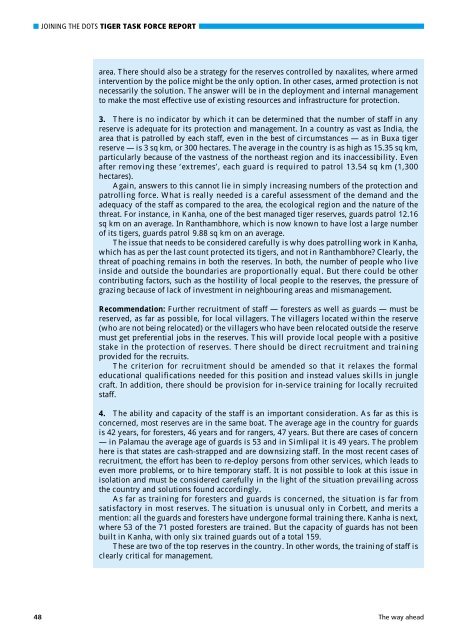Report of the Tiger Task Force - PRS
Report of the Tiger Task Force - PRS
Report of the Tiger Task Force - PRS
You also want an ePaper? Increase the reach of your titles
YUMPU automatically turns print PDFs into web optimized ePapers that Google loves.
■ JOINING THE DOTS TIGER TASK FORCE REPORTarea. There should also be a strategy for <strong>the</strong> reserves controlled by naxalites, where armedintervention by <strong>the</strong> police might be <strong>the</strong> only option. In o<strong>the</strong>r cases, armed protection is notnecessarily <strong>the</strong> solution. The answer will be in <strong>the</strong> deployment and internal managementto make <strong>the</strong> most effective use <strong>of</strong> existing resources and infrastructure for protection.3. There is no indicator by which it can be determined that <strong>the</strong> number <strong>of</strong> staff in anyreserve is adequate for its protection and management. In a country as vast as India, <strong>the</strong>area that is patrolled by each staff, even in <strong>the</strong> best <strong>of</strong> circumstances — as in Buxa tigerreserve — is 3 sq km, or 300 hectares. The average in <strong>the</strong> country is as high as 15.35 sq km,particularly because <strong>of</strong> <strong>the</strong> vastness <strong>of</strong> <strong>the</strong> nor<strong>the</strong>ast region and its inaccessibility. Evenafter removing <strong>the</strong>se ‘extremes’, each guard is required to patrol 13.54 sq km (1,300hectares).Again, answers to this cannot lie in simply increasing numbers <strong>of</strong> <strong>the</strong> protection andpatrolling force. What is really needed is a careful assessment <strong>of</strong> <strong>the</strong> demand and <strong>the</strong>adequacy <strong>of</strong> <strong>the</strong> staff as compared to <strong>the</strong> area, <strong>the</strong> ecological region and <strong>the</strong> nature <strong>of</strong> <strong>the</strong>threat. For instance, in Kanha, one <strong>of</strong> <strong>the</strong> best managed tiger reserves, guards patrol 12.16sq km on an average. In Ranthambhore, which is now known to have lost a large number<strong>of</strong> its tigers, guards patrol 9.88 sq km on an average.The issue that needs to be considered carefully is why does patrolling work in Kanha,which has as per <strong>the</strong> last count protected its tigers, and not in Ranthambhore? Clearly, <strong>the</strong>threat <strong>of</strong> poaching remains in both <strong>the</strong> reserves. In both, <strong>the</strong> number <strong>of</strong> people who liveinside and outside <strong>the</strong> boundaries are proportionally equal. But <strong>the</strong>re could be o<strong>the</strong>rcontributing factors, such as <strong>the</strong> hostility <strong>of</strong> local people to <strong>the</strong> reserves, <strong>the</strong> pressure <strong>of</strong>grazing because <strong>of</strong> lack <strong>of</strong> investment in neighbouring areas and mismanagement.Recommendation: Fur<strong>the</strong>r recruitment <strong>of</strong> staff — foresters as well as guards — must bereserved, as far as possible, for local villagers. The villagers located within <strong>the</strong> reserve(who are not being relocated) or <strong>the</strong> villagers who have been relocated outside <strong>the</strong> reservemust get preferential jobs in <strong>the</strong> reserves. This will provide local people with a positivestake in <strong>the</strong> protection <strong>of</strong> reserves. There should be direct recruitment and trainingprovided for <strong>the</strong> recruits.The criterion for recruitment should be amended so that it relaxes <strong>the</strong> formaleducational qualifications needed for this position and instead values skills in junglecraft. In addition, <strong>the</strong>re should be provision for in-service training for locally recruitedstaff.4. The ability and capacity <strong>of</strong> <strong>the</strong> staff is an important consideration. As far as this isconcerned, most reserves are in <strong>the</strong> same boat. The average age in <strong>the</strong> country for guardsis 42 years, for foresters, 46 years and for rangers, 47 years. But <strong>the</strong>re are cases <strong>of</strong> concern— in Palamau <strong>the</strong> average age <strong>of</strong> guards is 53 and in Simlipal it is 49 years. The problemhere is that states are cash-strapped and are downsizing staff. In <strong>the</strong> most recent cases <strong>of</strong>recruitment, <strong>the</strong> effort has been to re-deploy persons from o<strong>the</strong>r services, which leads toeven more problems, or to hire temporary staff. It is not possible to look at this issue inisolation and must be considered carefully in <strong>the</strong> light <strong>of</strong> <strong>the</strong> situation prevailing across<strong>the</strong> country and solutions found accordingly.As far as training for foresters and guards is concerned, <strong>the</strong> situation is far fromsatisfactory in most reserves. The situation is unusual only in Corbett, and merits amention: all <strong>the</strong> guards and foresters have undergone formal training <strong>the</strong>re. Kanha is next,where 53 <strong>of</strong> <strong>the</strong> 71 posted foresters are trained. But <strong>the</strong> capacity <strong>of</strong> guards has not beenbuilt in Kanha, with only six trained guards out <strong>of</strong> a total 159.These are two <strong>of</strong> <strong>the</strong> top reserves in <strong>the</strong> country. In o<strong>the</strong>r words, <strong>the</strong> training <strong>of</strong> staff isclearly critical for management.48 The way ahead
















